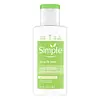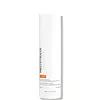What's inside
What's inside
 Key Ingredients
Key Ingredients

 Benefits
Benefits

 Concerns
Concerns

 Ingredients Side-by-side
Ingredients Side-by-side

Butyl Methoxydibenzoylmethane 2%
UV AbsorberPhenylbenzimidazole Sulfonic Acid 1.5%
UV AbsorberEthylhexyl Salicylate 5%
UV AbsorberOctocrylene 1.3%
UV AbsorberWater
Skin ConditioningGlycerin
HumectantStearic Acid
CleansingGlycol Stearate
EmollientPEG-100 Stearate
Dimethicone
EmollientTocopheryl Acetate
AntioxidantPanthenol
Skin ConditioningAllantoin
Skin ConditioningBisabolol
MaskingGlyceryl Stearate
EmollientPotassium Stearate
CleansingCaprylyl Glycol
EmollientPhenoxyethanol
PreservativeCarbomer
Emulsion StabilisingCetyl Alcohol
EmollientBHT
AntioxidantXanthan Gum
EmulsifyingDisodium EDTA
Stearamide Amp
Butyl Methoxydibenzoylmethane 2%, Phenylbenzimidazole Sulfonic Acid 1.5%, Ethylhexyl Salicylate 5%, Octocrylene 1.3%, Water, Glycerin, Stearic Acid, Glycol Stearate, PEG-100 Stearate, Dimethicone, Tocopheryl Acetate, Panthenol, Allantoin, Bisabolol, Glyceryl Stearate, Potassium Stearate, Caprylyl Glycol, Phenoxyethanol, Carbomer, Cetyl Alcohol, BHT, Xanthan Gum, Disodium EDTA, Stearamide Amp
Butyl Methoxydibenzoylmethane 3%
UV AbsorberEthylhexyl Methoxycinnamate 7.5%
UV AbsorberEthylhexyl Salicylate 5%
UV AbsorberWater
Skin ConditioningAcetyl Glucosamine
Skin ConditioningButyloctyl Salicylate
Skin ConditioningCyclopentasiloxane
EmollientDimethicone
EmollientC12-15 Alkyl Benzoate
AntimicrobialGlycerin
HumectantButylene Glycol
HumectantGlyceryl Stearate
EmollientOctyldodecyl Neopentanoate
EmollientCetyl Alcohol
EmollientPEG-100 Stearate
Cetearyl Alcohol
EmollientVitis Vinifera Seed Extract
AntimicrobialMelia Azadirachta Leaf Extract
Skin ConditioningLecithin
EmollientArctium Lappa Root Extract
Skin ConditioningTocopheryl Acetate
AntioxidantDimethicone Crosspolymer
Emulsion StabilisingPropylene Glycol
HumectantPEG-75 Stearate
Steareth-20
CleansingXanthan Gum
EmulsifyingCeteth-20
CleansingAmmonium Hydroxide
BufferingCarbomer
Emulsion StabilisingDisodium EDTA
Caprylyl Glycol
EmollientPhenoxyethanol
PreservativeChlorphenesin
AntimicrobialSodium Bisulfite
AntioxidantButyl Methoxydibenzoylmethane 3%, Ethylhexyl Methoxycinnamate 7.5%, Ethylhexyl Salicylate 5%, Water, Acetyl Glucosamine, Butyloctyl Salicylate, Cyclopentasiloxane, Dimethicone, C12-15 Alkyl Benzoate, Glycerin, Butylene Glycol, Glyceryl Stearate, Octyldodecyl Neopentanoate, Cetyl Alcohol, PEG-100 Stearate, Cetearyl Alcohol, Vitis Vinifera Seed Extract, Melia Azadirachta Leaf Extract, Lecithin, Arctium Lappa Root Extract, Tocopheryl Acetate, Dimethicone Crosspolymer, Propylene Glycol, PEG-75 Stearate, Steareth-20, Xanthan Gum, Ceteth-20, Ammonium Hydroxide, Carbomer, Disodium EDTA, Caprylyl Glycol, Phenoxyethanol, Chlorphenesin, Sodium Bisulfite
 Reviews
Reviews

Ingredients Explained
These ingredients are found in both products.
Ingredients higher up in an ingredient list are typically present in a larger amount.
Also known as Avobenzone, this ingredient is a chemical sunscreen filter that provides protection in the UV-A range.
Avobenzone is globally approved and is the most commonly used UV-A filter in the world.
Studies have found that avobenzone becomes ineffective when exposed to UV light (it is not photostable; meaning that it breaks down in sunlight). Because of this, formulations that include avobenzone will usually contain stabilizers such as octocrylene.
However, some modern formulations (looking at you, EU!) are able to stabilize avobenzone by coating the molecules.
Avobenzone does not protect against the UV-B range, so it's important to check that the sunscreen you're using contains other UV filters that do!
The highest concentration of avobenzone permitted is 3% in the US, and 5% in the EU.
Learn more about Butyl MethoxydibenzoylmethaneCaprylyl Glycol is a humectant and emollient, meaning it attracts and preserves moisture.
It is a common ingredient in many products, especially those designed to hydrate skin. The primary benefits are retaining moisture, skin softening, and promoting a healthy skin barrier.
Though Caprylyl Glycol is an alcohol derived from fatty acids, it is not the kind that can dry out skin.
This ingredient is also used as a preservative to extend the life of products. It has slight antimicrobial properties.
Learn more about Caprylyl GlycolCarbomer is a polymer of acrylic acid. Its main role is to create a gel consistency.
A high amount of carbomer can cause pilling or balling up of products. Don't worry, most products contain 1% or less of carbomer.
Cetyl Alcohol is a fatty alcohol. Fatty Alcohols are most often used as an emollient or to thicken a product.
Its main roles are:
Though it has "alcohol" in the name, it is not related to denatured alcohol or ethyl alcohol.
The FDA allows products labeled "alcohol-free" to have fatty alcohols.
Learn more about Cetyl AlcoholDimethicone is a type of synthetic silicone created from natural materials such as quartz.
What it does:
Dimethicone comes in different viscosities:
Depending on the viscosity, dimethicone has different properties.
Ingredients lists don't always show which type is used, so we recommend reaching out to the brand if you have questions about the viscosity.
This ingredient is unlikely to cause irritation because it does not get absorbed into skin. However, people with silicone allergies should be careful about using this ingredient.
Note: Dimethicone may contribute to pilling. This is because it is not oil or water soluble, so pilling may occur when layered with products. When mixed with heavy oils in a formula, the outcome is also quite greasy.
Learn more about DimethiconeDisodium EDTA plays a role in making products more stable by aiding other preservatives.
It is a chelating agent, meaning it neutralizes metal ions that may be found in a product.
Disodium EDTA is a salt of edetic acid and is found to be safe in cosmetic ingredients.
Learn more about Disodium EDTAEthylhexyl Salicylate is an organic compound used to block UV rays. It primarily absorbs UVB rays but offers a small amount of UVA protection as well.
Commonly found in sunscreens, Ethylhexyl Salicylate is created from salicylic acid and 2-ethylhexanol. You might know salicylic acid as the effective acne fighter ingredient and BHA.
The ethylhexanol in this ingredient is a fatty alcohol and helps hydrate your skin, similar to oils. It is an emollient, which means it traps moisture into the skin.
According to manufacturers, Ethylhexyl Salicylate absorbs UV wavelength of 295-315 nm, with a peak absorption at 307-310 nm. UVA rays are linked to long term skin damage, such as hyperpigmentation. UVB rays emit more energy and are capable of damaging our DNA. UVB rays cause sunburn.
Learn more about Ethylhexyl SalicylateGlycerin is already naturally found in your skin. It helps moisturize and protect your skin.
A study from 2016 found glycerin to be more effective as a humectant than AHAs and hyaluronic acid.
As a humectant, it helps the skin stay hydrated by pulling moisture to your skin. The low molecular weight of glycerin allows it to pull moisture into the deeper layers of your skin.
Hydrated skin improves your skin barrier; Your skin barrier helps protect against irritants and bacteria.
Glycerin has also been found to have antimicrobial and antiviral properties. Due to these properties, glycerin is often used in wound and burn treatments.
In cosmetics, glycerin is usually derived from plants such as soybean or palm. However, it can also be sourced from animals, such as tallow or animal fat.
This ingredient is organic, colorless, odorless, and non-toxic.
Glycerin is the name for this ingredient in American English. British English uses Glycerol/Glycerine.
Learn more about GlycerinGlyceryl Stearate is a mix of glycerin and stearic acid.
It is used to stabilize the mixing of water and oil ingredients. By preventing these ingredients from separating, it can help elongate shelf life. It can also help thicken the product's texture.
As an emollient, it helps soften skin and supports barrier-replenishing ingredients.
In cosmetics, Glyceryl Stearate is often made from vegetable oils or synthetically produced.
This ingredient may not be fungal-acne safe
Fun fact: The human body also creates Glyceryl Stearate naturally.
Learn more about Glyceryl StearatePeg-100 Stearate is an emollient and emulsifier. As an emollient, it helps keep skin soft by trapping moisture in. On the other hand, emulsifiers help prevent oil and water from separating in a product.
PEGS are a hydrophilic polyether compound . There are 100 ethylene oxide monomers in Peg-100 Stearate. Peg-100 Stearate is polyethylene glycol ester of stearic acid.
Phenoxyethanol is a preservative that has germicide, antimicrobial, and aromatic properties. Studies show that phenoxyethanol can prevent microbial growth. By itself, it has a scent that is similar to that of a rose.
It's often used in formulations along with Caprylyl Glycol to preserve the shelf life of products.
Tocopheryl Acetate is AKA Vitamin E. It is an antioxidant and protects your skin from free radicals. Free radicals damage the skin by breaking down collagen.
One study found using Tocopheryl Acetate with Vitamin C decreased the number of sunburned cells.
Tocopheryl Acetate is commonly found in both skincare and dietary supplements.
Learn more about Tocopheryl AcetateWater. It's the most common cosmetic ingredient of all. You'll usually see it at the top of ingredient lists, meaning that it makes up the largest part of the product.
So why is it so popular? Water most often acts as a solvent - this means that it helps dissolve other ingredients into the formulation.
You'll also recognize water as that liquid we all need to stay alive. If you see this, drink a glass of water. Stay hydrated!
Learn more about WaterXanthan gum is used as a stabilizer and thickener within cosmetic products. It helps give products a sticky, thick feeling - preventing them from being too runny.
On the technical side of things, xanthan gum is a polysaccharide - a combination consisting of multiple sugar molecules bonded together.
Xanthan gum is a pretty common and great ingredient. It is a natural, non-toxic, non-irritating ingredient that is also commonly used in food products.
Learn more about Xanthan Gum